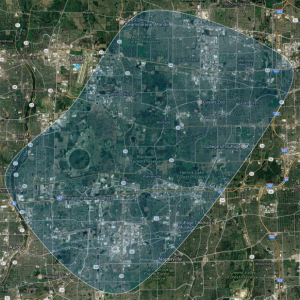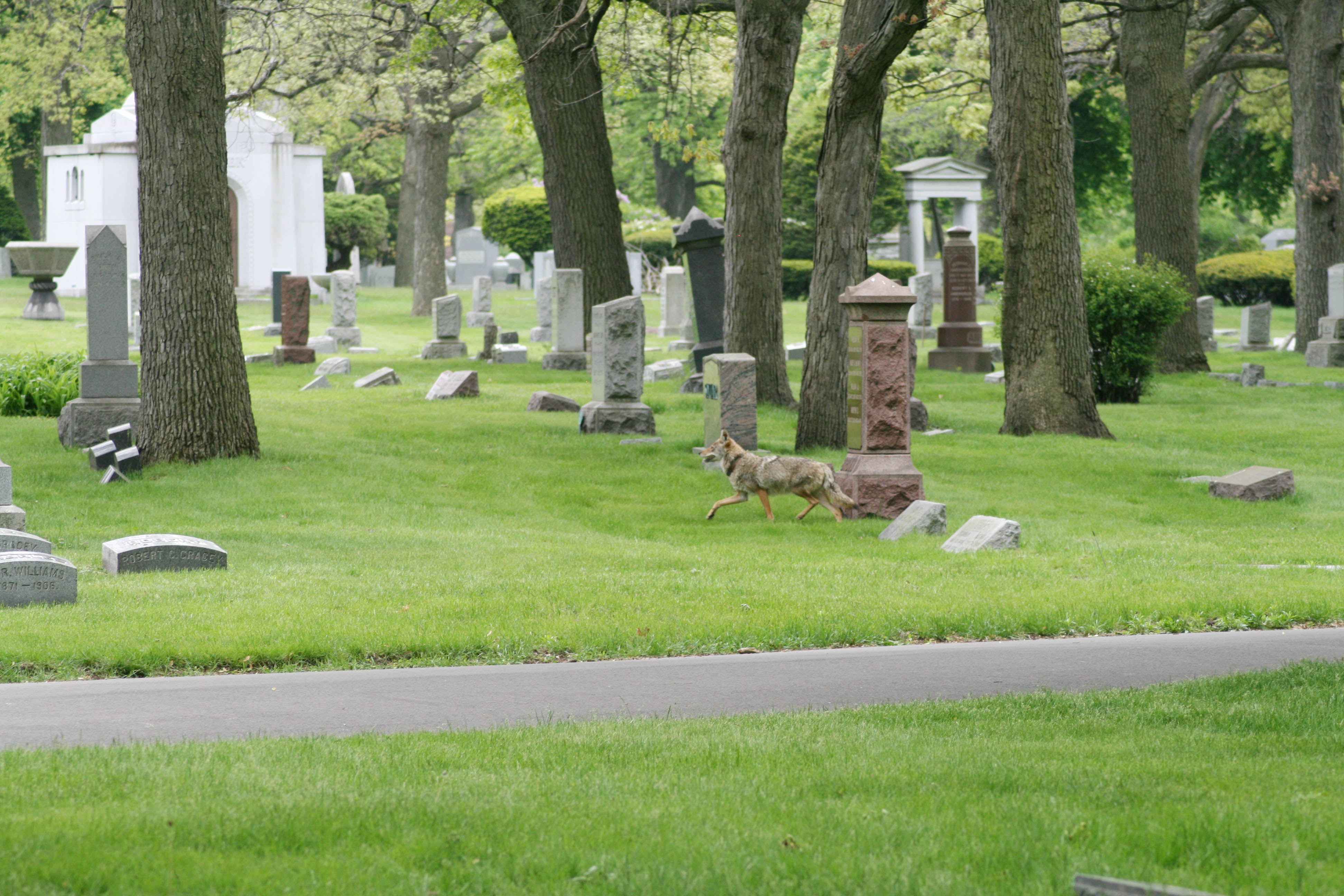
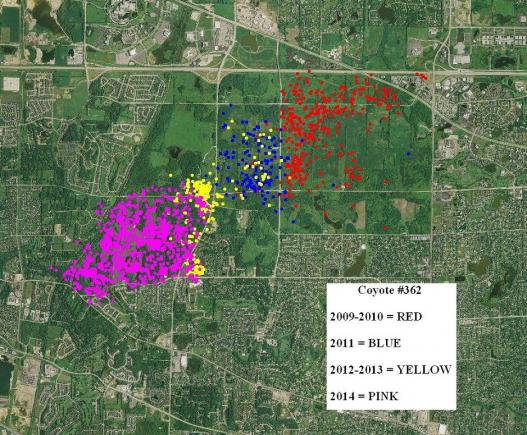
Coyote 362: these locations allow us to track changes in home range over time
Tracking with GPS and VHF Collars
GPS-collars and VHF (Very High Frequency) radio-collars allow researchers to identify the location of coyotes throughout the day and night without disturbing normal animal routines. Coyote locations are recorded as coordinates and entered into a Geographic Information System (GIS) in order to determine activity patterns, home ranges, territories, and habitat selection.
Activity Patterns in Urban Environments
Coyotes in the Chicago metropolitan area appear to confine most of their activity to nocturnal hours, which has been observed by virtually all studies of urban coyotes, whereas in natural areas, coyotes tend to be diurnal (active during the day) or crepuscular (active at dawn and dusk). The activity patterns of coyotes depend upon many environmental and individual factors, such as the availability of prey, avoidance of predation or human-related activities, and life-history strategies, such as hunting strategies and social organization.
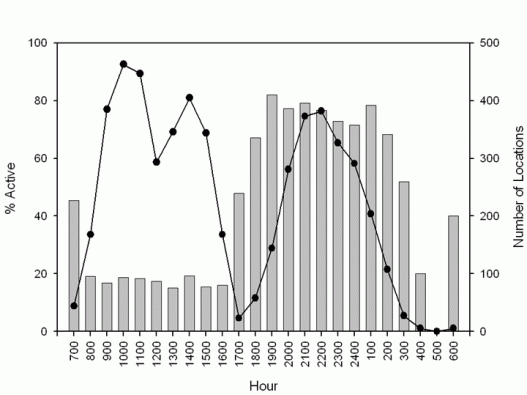
Figure 1. Patterns of activity of radio-collared coyotes
Fig. 1.-- Patterns of activity for radio collared coyotes in the Chicago metropolitan area from 2000 to 2002. Bars represent the proportion of locations in which a coyote was active per hour of radio telemetry. Dots/lines represent the number of locations recorded per hour.
Switching to nocturnal activity patterns in urban areas may be an adaptive response that allows coyotes to minimize contact with humans, reducing risks associated with encounters while still allowing them to exploit the environment. However, coyotes are likely to individually vary in their responses to human activity even within the same population area.
Coyote responses to people may depend upon the degree to which coyotes can habituate to humans or find shelter from them.
Home Ranges and Territories
Home ranges are the areas used by animals to meet their daily needs and may overlap with home ranges of neighboring animals. Home range size can be an important indicator of habitat quality or the distribution of resources. Territories are part of home ranges and are defended by the pack from other individuals or groups.
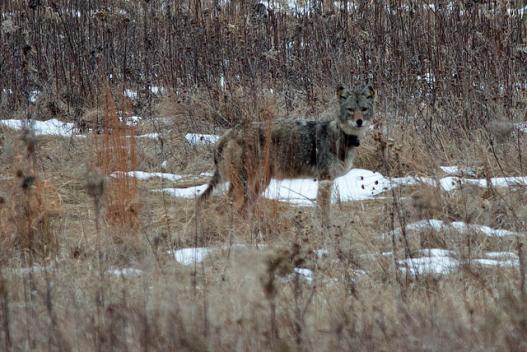
This coyote calls a forest preserve in Hoffman Estates "home." Photo credit Stanley J. Jazwinski
Other coyote studies have shown that territory sizes decrease with increased urbanization given adequate food is available. In general, research has found that urban coyotes tend to have smaller territories than rural coyotes. Many coyote territories are associated with large parks or forest preserves, which provide an abundance of cover and food. In these cases, the boundaries of territories will often follow the park boundaries.
It was interesting to discover, however, that other coyotes have been able to establish territories and form packs without the benefit of large blocks of habitats. This formation of packs and territories can even occur in downtown areas, if parks or natural areas exist in scattered, small patches. Sometimes these are coyotes that have created territories in residential areas or complexes of small parks and golf courses.
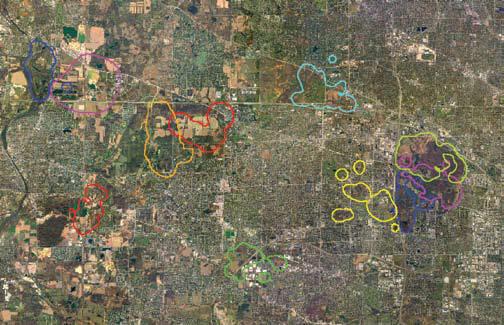
Figure 2. Distribution of coyote packs (example)
In either case, coyotes manage to defend these territories so that the territories have very little overlap, which controls their density and spatial arrangement across the landscape. This is frequently called a land-tenure system. There is still much to learn about how coyotes maintain packs in downtown areas. See the coyote stories page for examples of how some coyotes live in downtown Chicago and suburban areas.
Fig. 2.-- Distribution of coyote packs during 2004. The area of the map encompasses at least 12 cities over 260 square miles. Each color represents the home range of an alpha male or female that represents the territorial boundary for the pack. Some territories are fragmented as a result of the computer model used to estimate the boundaries, but it is obvious that territories have only limited overlap.
Solitary vs Pack Coyotes
Radio-tracking revealed two different types of movement patterns affecting home range size among coyotes in Cook County. These differences were related to social behavior: whether a coyote was associated with a pack (pack coyote) or not (solitary coyote).
Pack coyotes, also known as resident coyotes, are those that belong to a pack. Coyotes in a pack share a territory, which they defend together. In Cook County, pack coyotes have smaller territories than solitary coyotes, averaging less than 2 square miles (4.95 km2) but as large as 4.3 square miles (11.1km2).
Solitary coyotes, also sometimes known as transient coyotes, are those coyotes that do not yet belong to a pack and therefore do not have a territory that they defend. In Cook County, solitary coyotes range over much larger areas and have home ranges averaging 10 square miles (26.8 km2). Unlike home ranges of many coyote residents, home ranges of transients were not composed exclusively within natural fragments, although natural land cover was still the most used land-cover type.
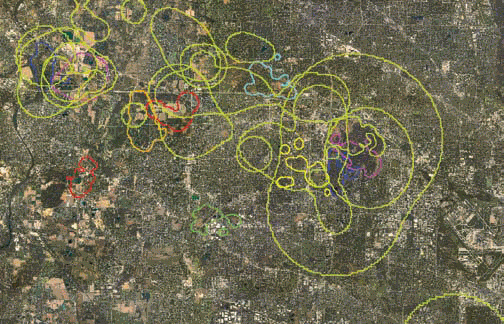
Figure 3. Distribution of coyote home ranges (Chicago suburbs example)
Fig. 3.-- Distribution of coyote home ranges during 2004. Light green lines represent the home ranges of solitary coyotes, while the smaller colored areas represent the territorial boundaries of packs (as seen in the previous figure). O’Hare International Airport is located in the lower right corner. The large home ranges of solitary coyotes overlap territories of packs as well as home ranges of other solitary individuals.
As the Cook County Coyote Project has progressed, individual coyotes have been followed as they change from solitary coyotes with large movement patterns to social groups with small territories (and vice versa). Approximately 50% of the coyotes radio-collared as subadults (one to two years of age) or adults have been solitary for at least a portion of the study.
The home ranges of solitary coyotes span large portions of the metropolitan area, and they overlap extensively with pack territories as well as other solitary coyotes. Solitary coyotes use a wide variety of habitats and can be found in virtually any part of the metropolitan area, even in downtown areas. Some solitary coyotes have been observed finding mates and establishing their own territories, whereas others eventually disperse and leave the area permanently. In a few cases, resident adult coyotes have left their territories after the death of a mate.
Habitat Selection
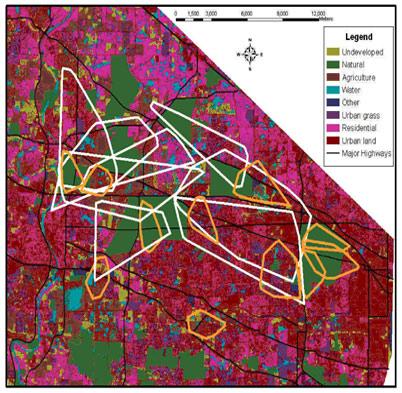
Figure 4. Distribution of home ranges among habitat types (Chicago area)
Despite differences in the size of home ranges, resident and solitary coyotes in general both rely on using natural areas heavily and avoid urban grass, residential and urban land areas.
Fig. 4.-- Distribution of annual home ranges of resident (yellow lines) and solitary (white lines) coyotes in the Chicago metropolitan area during 2004.
For example, in Cook County, home ranges of resident coyotes are typically associated with natural habitats and in many cases these home ranges exist almost completely within large habitat fragments. The boundaries of coyote home ranges usually follow the borders between parks and surrounding development. However, it has also been found that individuals vary in their use of habitat; 29% of collared coyotes have home ranges composed of less than 10% of natural land and 8% having no measurable patches of natural land within their home ranges.
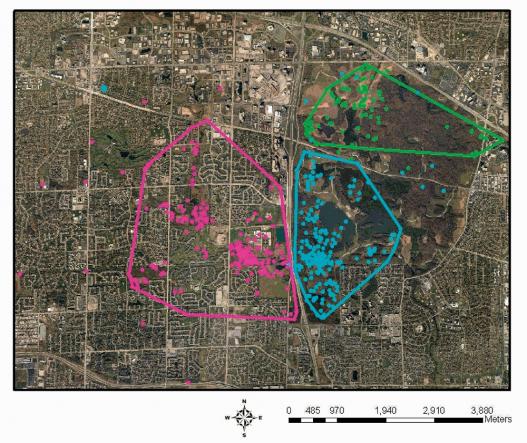
Figure 5. Habitat use variability between coyotes map (Chicago area)
Locations of collared coyotes still indicate that they avoid human areas either by restricting their movements to boundaries of natural habitat fragments or by focusing their activities within a series of smaller patches of undeveloped areas within their home ranges. These findings support previous diet research in the study area, which found that food items associated with natural areas (such as rodents and fruit) dominate the coyote diet, rather than human-related food items.
Fig. 5.-- These locations of radio-collared coyotes illustrate coyote selection of natural areas and avoidance of residential areas within their home ranges.


